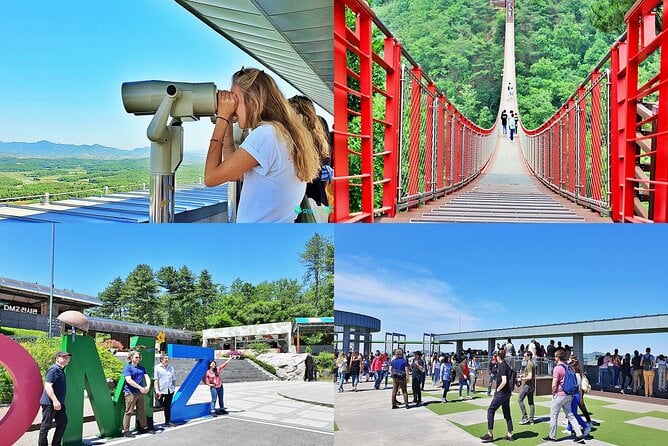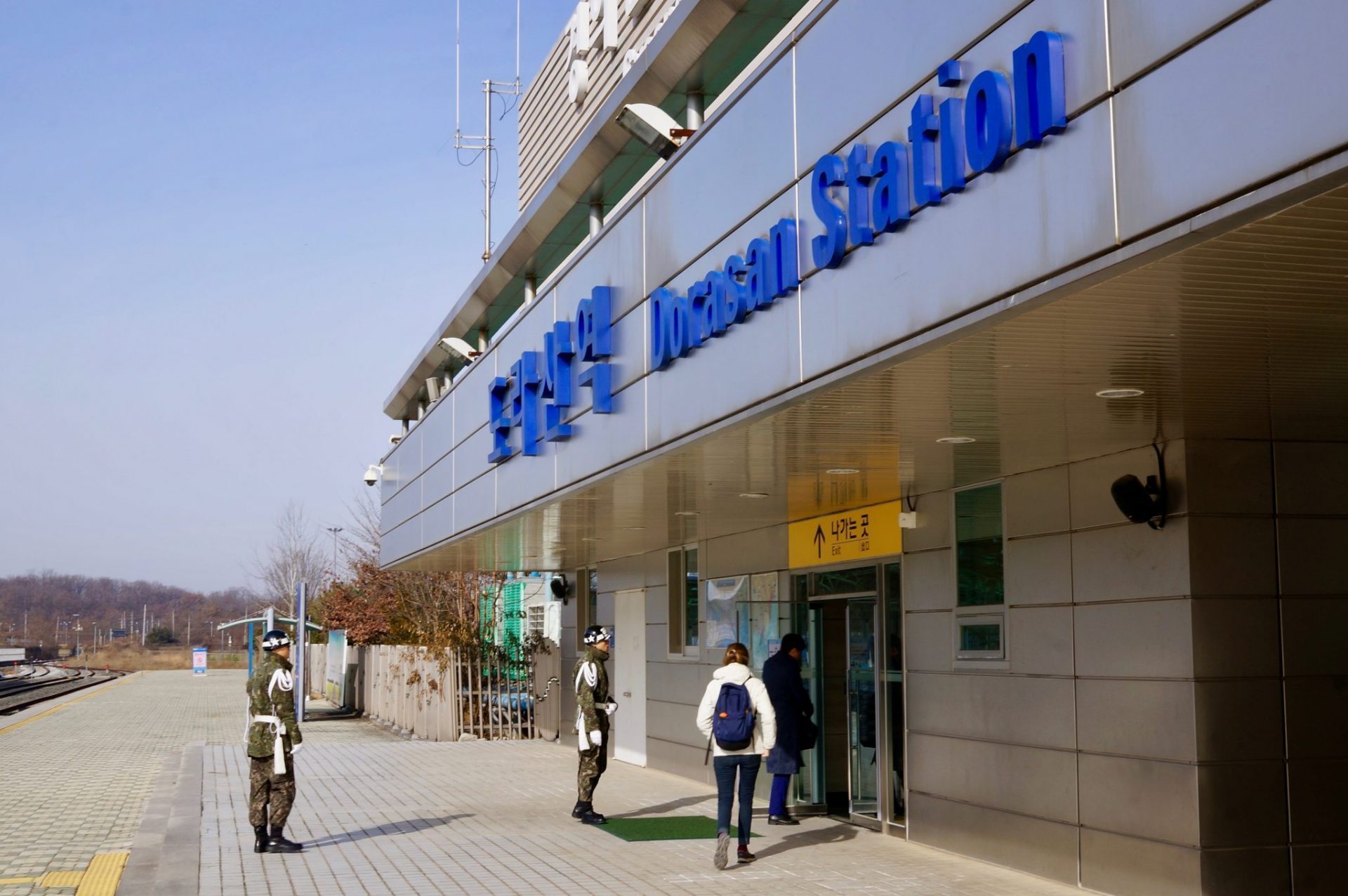Understanding the DMZ: An Overview

The Demilitarized Zone (DMZ) is a buffer zone between North and South Korea. It’s about 250 kilometers long and 4 kilometers wide. Established in 1953 after the Korean War, the area symbolizes the division of the Korean Peninsula. The DMZ is one of the most heavily fortified borders in the world. It holds historical significance for Korea and serves as a crucial reminder of the past conflict and ongoing tensions. Joining a tour allows you to learn more about this unique and complex area.
1 DMZ: Definition and historical significance
The DMZ stands for the Demilitarized Zone, a buffer zone between North and South Korea. Since 1953, it has symbolized the division of the Korean Peninsula after the Korean War. The DMZ is significant historically as it represents the ongoing tensions and separation between the two Koreas. As a traveler, understanding the history and purpose of the DMZ can provide insight into the complexities of the Korean conflict and its lasting impact on the region.
2 Demilitarized Zone: Purpose and location
The Demilitarized Zone (DMZ) serves as a buffer between North and South Korea. It aims to maintain peace and prevent military conflicts. The location of the DMZ runs approximately along the 38th parallel and spans about 160 miles across the Korean Peninsula. This area is heavily guarded and restricted to civilians, highlighting the tense division between the two Korean nations. Visiting the DMZ offers a glimpse into this unique and heavily fortified border.
Demarcation Line and Panmunjom Joint Security Area
The Demarcation Line marks the actual border between North and South Korea, heavily guarded and restricted. Visit the Panmunjom Joint Security Area for a close-up view of this tense division. You can see the actual meeting rooms where discussions between the two nations take place. As a visitor, you’ll sense the high security and importance of this area for maintaining peace on the Korean Peninsula. The tours here offer unique insights into the complex dynamics between North and South Korea.
1 Demarcation Line: Borders and restrictions

The Demarcation Line is a heavily guarded border that separates North and South Korea. You can’t cross this line as it’s a restricted area with high security. Military personnel closely monitor this border to maintain peace and stability. Photography is limited in this sensitive zone, and visitors must follow strict rules and guidelines to ensure their safety and the security of the area. Respect these boundaries to experience the history and tension of the Korean Peninsula up close.
2 Panmunjom Joint Security Area: Tourist attractions and significance
Explore the Panmunjom Joint Security Area for an immersive experience. Witness the iconic blue buildings where official meetings between North and South Korea take place. Capture a rare glimpse of North Korean soldiers standing guard just meters away. Visit the Bridge of No Return, a historic site symbolizing the division of Korea. Understand the tense but intriguing atmosphere of this area, which holds the key to the fragile peace between the two nations.
Historic Sites within the DMZ

Discover iconic historic sites within the DMZ that showcase the region’s rich history. Explore the Third Tunnel of Aggression, a tunnel dug by North Korea for potential invasion. Visit Dorasan Station, a symbol of hope for reunification. Learn about the significance of these sites in the context of Korean division and reunification efforts. Immerse yourself in the stories and symbolism that make these historic sites integral parts of the DMZ experience.
1 Third Tunnel of Aggression: History and exploration
Descend into the Third Tunnel of Aggression to witness a piece of hidden history. Explore the tunnel dug by North Korea beneath the DMZ for potential invasion. Feel the narrow walls and low ceilings, reminding you of the tensions that once gripped this underground passage. Learn about the military significance of this tunnel and the efforts made to uncover and preserve its secrets. Experience the eerie atmosphere as you journey through a vital part of Korean history.
2 Dorasan Station: Symbolism and reunification hopes

At Dorasan Station, witness the symbolic gateway to a unified Korea. The station stands as a beacon of hope for reunification between North and South Korea. Feel the significance of this location, once envisioned as a connection point for trains traveling between the two nations. Explore the empty platforms and imagine a future where trains will carry passengers freely across borders. Experience the poignant reminder of the divided Korean peninsula at Dorasan Station.
Wildlife and Nature Conservation in the DMZ
Explore the DMZ’s diverse ecosystem. Discover rare plant species and unique wildlife thriving in the area. The DMZ acts as an accidental sanctuary, untouched by human interference. Endangered species find refuge in this protected zone. Witness the harmony of nature reclaiming its space amidst the remnants of conflict. Conservation efforts are crucial to preserve this fragile balance. Immerse yourself in the beauty of nature’s resilience within the DMZ.
1 Biodiversity in the DMZ: Flora and fauna

Marvel at the diverse plant life like wild ginseng and Hanabusaya Asiatica. Discover native animal species such as the endangered Amur goral and Asiatic black bear. The DMZ nurtures rare birds like the red-crowned crane and black-faced spoonbill. Spot Korean hazel hen and Eurasian otters roaming freely in this protected haven. Experience the rich biodiversity flourishing in the untouched wilderness of the Demilitarized Zone.
2 Conservation efforts and ecological significance
Learn about the dedicated conservation efforts in the DMZ, preserving its unique ecosystems. These initiatives aim to protect endangered species and maintain the natural balance of the region. By restricting human interference and allowing nature to thrive, the DMZ serves as a crucial ecological sanctuary. Your visit contributes to raising awareness about the importance of conserving this pristine environment for future generations. Appreciate the ecological significance of safeguarding biodiversity in this untouched wilderness.
DMZ Tours and Visitor Information

When planning your visit to the DMZ, keep in mind that tours are carefully guided and have specific restrictions. You’ll have the chance to explore key sites within the area under the supervision of knowledgeable tour guides. Remember to book your tour in advance due to high demand and limited availability. Be prepared for security checkpoints and follow instructions diligently during your visit to ensure a safe and unforgettable experience in this unique and historically significant zone.
1 Tour options and restrictions
When choosing a DMZ tour, consider options like half-day or full-day tours. Keep in mind that access to certain areas may be restricted due to security reasons, so follow instructions from your guide. Remember to bring your passport for identification purposes. Note that photography and video recordings may be limited in specific locations for security purposes. Follow the rules and guidelines set by the tour operators to ensure a smooth and enjoyable experience during your visit.
2 What to expect and how to book a DMZ tour

To book a DMZ tour, research reputable tour companies online or through your hotel. Expect security checks and regulations before the tour. Wear comfortable clothing and shoes for walking. Bring your passport for identification, water, and snacks. Tours may include visits to tunnels, observation points, and historic sites. You may have limited photo opportunities in certain areas. Follow instructions from your guide for a safe and enjoyable experience. Book in advance to secure your spot.
Conclusion
Reflect on your DMZ journey with a mix of awe and solemnity. The experience offers a glimpse into a divided land frozen in time. Remember the stories, sights, and emotions you encountered along the way. Cherish the opportunity to witness history and reflect on the importance of peace and unity. Your visit to the DMZ may leave a lasting impact, reminding you of the fragility of peace and the hope for reconciliation.
1 Reflecting on the DMZ experience

Recall the mix of emotions you felt as you stood at the heart of the divided Korean Peninsula. The silence of the DMZ reverberates with the weight of history – a testament to the enduring conflict and the longing for unity. Think about the stories shared by your guide, the sights that left you in awe, and the hope for peace that lingers in the air. Your visit to the DMZ is a poignant reminder of the complexities of this region and the importance of striving for harmony.
2 Tips for a memorable and safe visit to the Demilitarized Zone
To ensure a memorable and safe visit to the DMZ, always follow your guide’s instructions and stay within designated areas. Respect all rules and regulations, as they are in place for your safety and security. Additionally, dress warmly and wear comfortable shoes, as the weather at the DMZ can be unpredictable and the terrain uneven. Stay vigilant and be mindful of your surroundings at all times. By being cautious and respectful, you can have a meaningful experience while exploring this historic and symbolic site.
